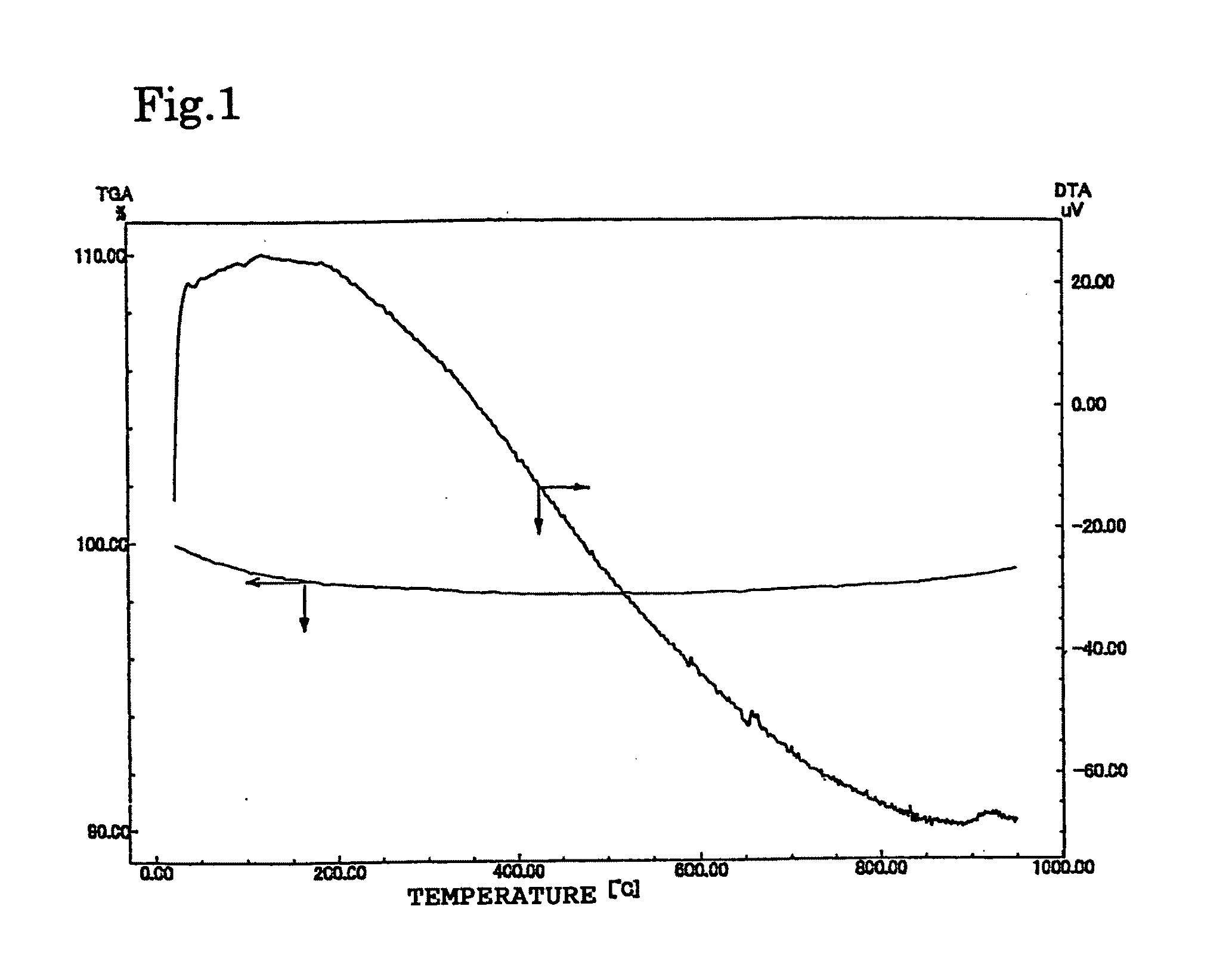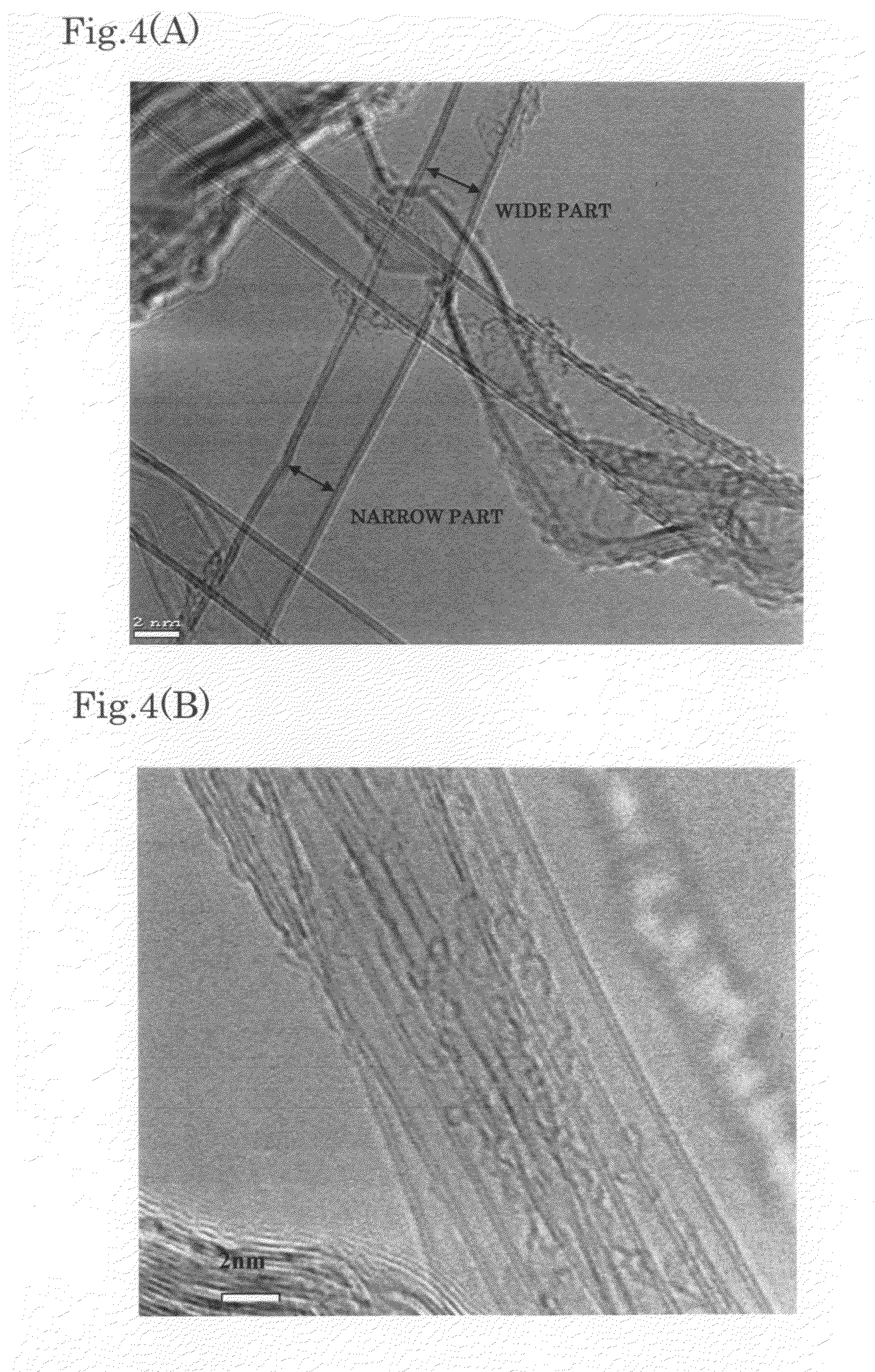Hollow nanofibers-containing composition
a technology of composition and hollow nanofiber, which is applied in the field of hollow nanofiber, hollow nanofiber, and catalyst composition for manufacturing hollow nanofiber, can solve the problems of many impurities such as amorphous carbon, the inability to reduce the detection of graphite layer, and the carbon nanotube obtained. to achieve the effect of facilitating separation and removal of the produced carbon nanotub
- Summary
- Abstract
- Description
- Claims
- Application Information
AI Technical Summary
Benefits of technology
Problems solved by technology
Method used
Image
Examples
example 1
Synthesis of Thermal Resistant Zeolite
[0154]Distilled water (164 g) was added to piperazinehexazhydrate (made by Aldrich) (18.9 g) and tetrapropylammonium bromide (made by Aldrich) (5.2 g), and it was agitated. The agitation was continued until dissolution while heating. Then, fumed silica (made by Aldrich) (11.7 g) was further added, and heating was executed up to 80° C. to obtain a transparent aqueous solution. This was put into an autoclave of poly 4-ethylene fluoride line, and heated at 150° C. for five days. Subsequently, the sample was cooled, filtered, washed by water, and dried, and then calcined at 550° C. in air.
[0155]X-ray diffraction (XRD) of obtained powder was measured to find that the sample was silicalite-1 having an MFI type structure. These powders were heated to 900° C. at a temperature rising rate of 5° C. / min, in a gas flow of nitrogen 50 ml / min, by Shimadzu Corporation's thermal analyzer, and no exothermic peak appears in a DTA curve (FIG. 1).
Carrying of Metal ...
example 2
Heat Resistance of Crystalline Titanosilicate
[0160]Titanosilicate powder (TS-1; Si / Ti ratio was 50) bought from NE Chemcat Corporation was subjected to X-ray diffraction (XRD) measurement to find TS-1 having an MFI type structure. These powders were heated to 900° C. at a temperature rising rate of 5° C. / min, in a gas flow of nitrogen 50 ml / min, by Shimadzu Corporation's thermal analyzer DTG-50, and no exothermic peak appeared in a DTA curve (FIG. 2).
[0161]This zeolite was calcined at 900° C. for 30 minutes, and then subjected to XRD diffraction to find a residual peak of the MFI type zeolite (FIG. 3).
Carrying of Metal Salt on Thermal Resistant Zeolite
[0162]Ferrous acetate (made by Aldrich) (0.08 g) and cobalt acetate 4 hydrate (made by Nacalai Tesque, Inc.) (0.11 g) were added to methanol (made by Nacalai Tesque, Inc.) (7 ml), and suspended by an ultrasonic cleaner for 10 minutes. Powder (1.0 g) of the TS-1 was added to this suspension, and the suspension was treated by the ultraso...
examples 3 , 4
Examples 3, 4
Comparative Example 2
[0183]A zeolite HSZ-390HUA (zeolite 1) of Tosoh Corporation was heated up to 900° C. at a temperature rising rate of 5° C. / min, in a gas flow of nitrogen 50 ml / min, by Shimadzu Corporation's thermal analyzer DTG-50. As a result, an exothermic peak appeared in a DTA curve (FIG. 11).
[0184]This zeolite was subjected to XRD measurement after burning in dry air at 900° C. for 30 minutes. A structure of a Y type zeolite was held, but a peak was sharper and larger than that before the burning (XRD before burning: FIG. 13, XRD after burning: FIG. 14). A certain structural change may have occurred during heating up to 900° C.
[0185]The zeolite HSZ-390HUA (zeolite 2) burned at 900° C. for 30 minutes, was heated up to 900° C. at a temperature rising rate of 5° C. min, in a gas flow of nitrogen 50 ml / min by Shimadzu Corporation's thermal analyzer DTG-50. As a result, change occurred so as to prevent appearance of an exothermic peak in a DTA curve (FIG. 12).
[0186...
PUM
| Property | Measurement | Unit |
|---|---|---|
| Nanoscale particle size | aaaaa | aaaaa |
| Nanoscale particle size | aaaaa | aaaaa |
Abstract
Description
Claims
Application Information
 Login to View More
Login to View More - R&D
- Intellectual Property
- Life Sciences
- Materials
- Tech Scout
- Unparalleled Data Quality
- Higher Quality Content
- 60% Fewer Hallucinations
Browse by: Latest US Patents, China's latest patents, Technical Efficacy Thesaurus, Application Domain, Technology Topic, Popular Technical Reports.
© 2025 PatSnap. All rights reserved.Legal|Privacy policy|Modern Slavery Act Transparency Statement|Sitemap|About US| Contact US: help@patsnap.com



